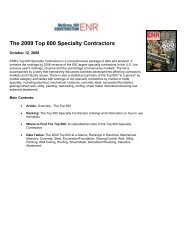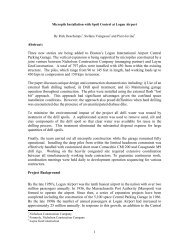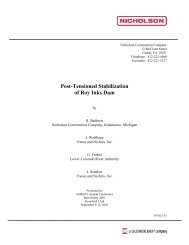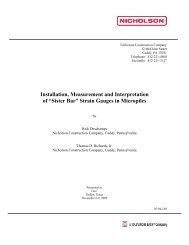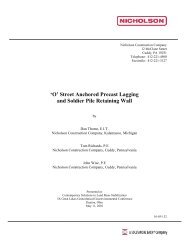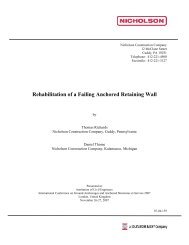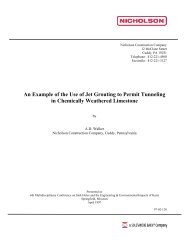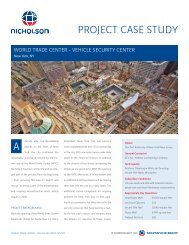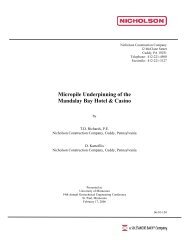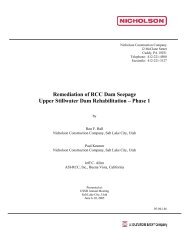recent advances in large diameter diaphragm wall shafts
recent advances in large diameter diaphragm wall shafts
recent advances in large diameter diaphragm wall shafts
- No tags were found...
Create successful ePaper yourself
Turn your PDF publications into a flip-book with our unique Google optimized e-Paper software.
assessment of specific concrete sections underthe vary<strong>in</strong>g state of stress. However, thisapproach is still conservative as it assumes thesoil pressure is constant. In reality, the soilpressure decreases with radial stra<strong>in</strong> thusreduc<strong>in</strong>g the bend<strong>in</strong>g moment. Other moresophisticated methods exist such as f<strong>in</strong>iteelements models, which are capable of com<strong>in</strong>gcloser to the real system, but <strong>in</strong> practice aredifficult to carry out.pressure. The Ha<strong>in</strong> solution takes account ofthe surround<strong>in</strong>g soil but not the threedimensional effects. The factors of safety givenby these two cases generally lead to a lowerbound of the overall factor of safety.Wall Open<strong>in</strong>gs. Circular <strong>wall</strong>s are relatively“easy” to calculate as long as the outsideload<strong>in</strong>g is symmetrical. However, theassessment of their behaviour becomes moredifficult when asymmetry occurs. For example,the case of a circular <strong>wall</strong> with an open<strong>in</strong>g is athree dimensional problem. The presence ofopen<strong>in</strong>g affects the <strong>in</strong>ternal forces <strong>in</strong> the <strong>wall</strong>.Because the hoop stresses can no longer begenerated at the open<strong>in</strong>g level, force equilibriumis balanced by higher stresses be<strong>in</strong>g generatedon both sides of the open<strong>in</strong>g as shownschematically <strong>in</strong> Figure 5. This concentration <strong>in</strong>compressive stress also produces a zone ofvertical tension due to the distortional stra<strong>in</strong>s.Additionally, the panels adjacent to the open<strong>in</strong>gtend to be "softer" produc<strong>in</strong>g <strong>large</strong>r bend<strong>in</strong>gmoments <strong>in</strong> the r<strong>in</strong>g at open<strong>in</strong>g level.(3) Displacement =>Bend<strong>in</strong>g momentFigure 4. Elliptical unsupported CSO shaft atMéricourt, France.Wall Buckl<strong>in</strong>g. The high compressive hoopstresses that are generated must also beevaluated <strong>in</strong> terms of buckl<strong>in</strong>g. This check isdifficult to carry out as the problem is threedimensional and non-l<strong>in</strong>ear. Three dimensionalbecause the surround<strong>in</strong>g soil pressure varieswith depth and there is restra<strong>in</strong>t from the passivesoil stress below the base and from the capbeam. It is non-l<strong>in</strong>ear because loads on the <strong>wall</strong>vary with stra<strong>in</strong>/displacement of the <strong>wall</strong>.Fortunately, closed-form solutions weredeveloped for some simple but related casesand these allow the factor of safety aga<strong>in</strong>stbuckl<strong>in</strong>g to be estimated. Timoshenko and Gere(1961) solved the case of a cyl<strong>in</strong>der fixed at itsends under a uniform pressure. Ha<strong>in</strong> (1968)solved the case of a r<strong>in</strong>g <strong>in</strong> <strong>in</strong>teraction with anelastic soil on the exterior. The Timoshenkosolution takes <strong>in</strong>to account some of the threedimensional effects but not the vary<strong>in</strong>g soil(1) Compression(2) TensionFigure 5. Changes <strong>in</strong> stresses aroundopen<strong>in</strong>gs <strong>in</strong> <strong>wall</strong>.The stress conditions can be evaluated with atwo dimensional approach. The <strong>in</strong>creasedbend<strong>in</strong>g moment can be estimated by reduc<strong>in</strong>gthe hoop stiffness at the open<strong>in</strong>g level. Thereduction factor is a function of the <strong>diameter</strong> of



